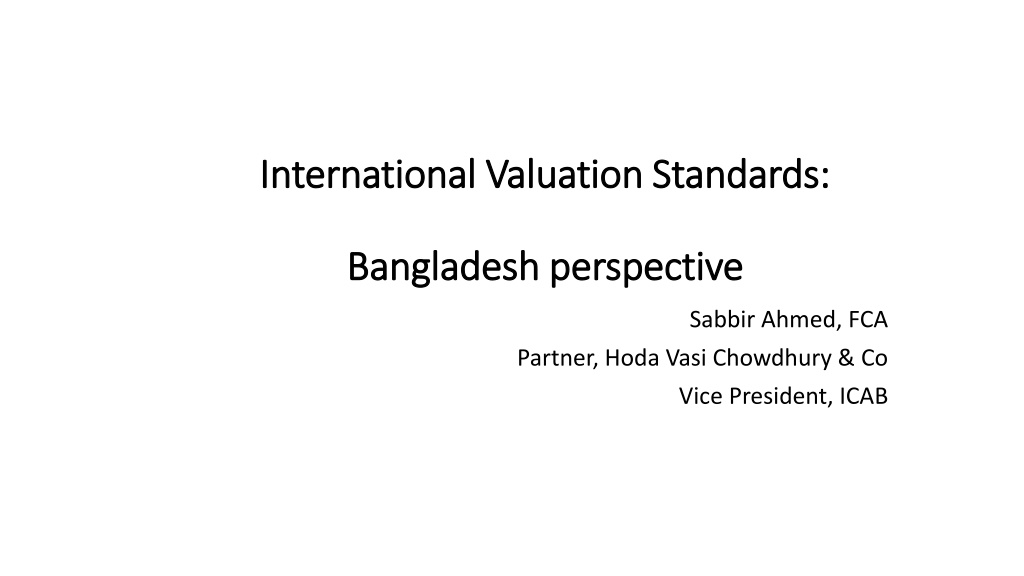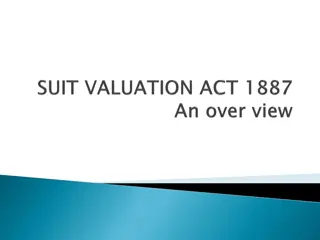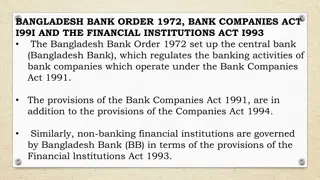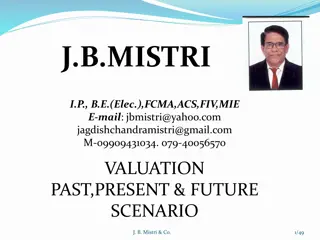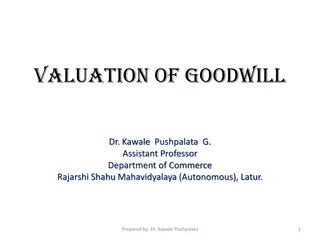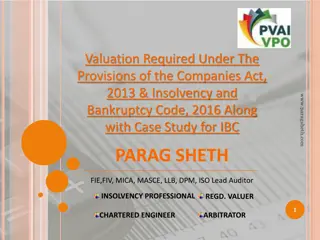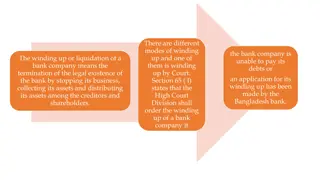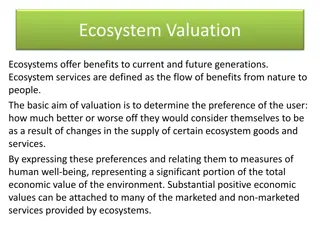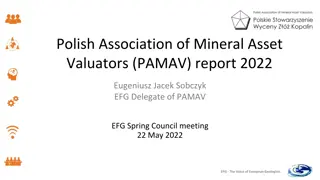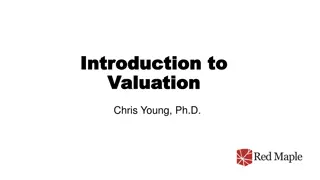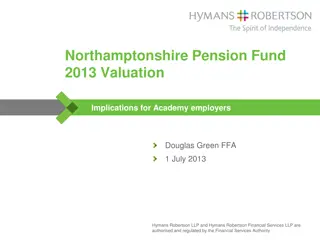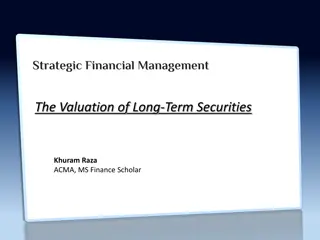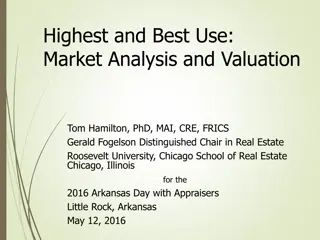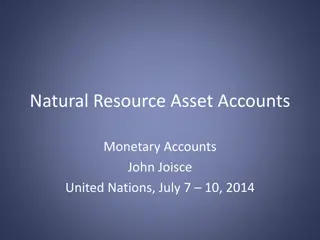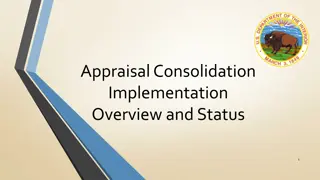Valuation Practices in Bangladesh: Insights and Guidelines
Exploring the valuation practices in Bangladesh, this article covers the use of valuations by banks, insurance companies, government entities, and more. It highlights the guidelines set by the Bangladesh Securities and Exchange Commission and the role of International Valuation Standards in asset valuation. Various scenarios where valuation plays a crucial role, such as loan approvals, claim settlements, and privatization processes, are discussed.
Download Presentation

Please find below an Image/Link to download the presentation.
The content on the website is provided AS IS for your information and personal use only. It may not be sold, licensed, or shared on other websites without obtaining consent from the author. Download presentation by click this link. If you encounter any issues during the download, it is possible that the publisher has removed the file from their server.
E N D
Presentation Transcript
International Valuation Standards: International Valuation Standards: Bangladesh perspective Bangladesh perspective Sabbir Ahmed, FCA Partner, Hoda Vasi Chowdhury & Co Vice President, ICAB
Valuation Some of the famous quotes on valuation from the Oracle of Omaha, Warren Buffett CEO Berkshire Hathaway Price is what you pay, value is what you get I don t look at the price first, I look at the business/company first and I try to value it. If I look at the price first I will get influenced by this. To me what is most important to value a business is what amount of return I will get (i.e. cash the business will pay to me), not what I will get by selling it to somebody. Because once I get into selling it become a game of who beat who. If you are an investor you will look at what the asset is producing, what the cash flow the business will give. If you are a speculator you are focusing on what the price of the object will be independent of business.
Global practices used in valuation International Valuation Standards (IVS) issued by International Valuation Standards Council (IVSC). International Financial Reporting Standards issued by IFRS Foundation (in particular IFRS 13 Fair Value Measurement) the term used is Fair Value . The Financial Accounting Standards Board in the United States uses the same definition of Fair Value in Topic 820. Fair Market Value by Organisation for Economic Co-operation and Development (OECD) for international tax. Regulations issued by various securities regulators, central banks, taxation authorities etc. (United States Internal Revenue Service or other taxation and regulatory body). Various Directives issued by professional institutes like (AICPA, ICAEW, CAANZ, HKICPA, ICAI etc.) Other generally accepted basis for fair valuation (i.e. the Model Business Corporation Act, Canadian case law (Manning v Harris Steel Group Inc).
Valuation practices used in Bangladesh Banks and NBFIs use valuation to determine value of eligible security (collateral) as part of loan approval process as well as to calculate specific provision for classified loans. Such valuation is mostly done by their enlisted surveyors Valuation is also used by Insurance companies as part of claim settlement process. Such valuation is mostly done by their enlisted surveyors. Valuation done by a various government entities as part of privatization/capitalization process. Valuation used as part of the Scheme of Amalgamation submitted to the Court. As per BSEC Notification No. SEC/CMRRCD/2009-193/150/Admin dated August 18, 2013 Bangladesh Securities and Exchange Commission has issued guidelines for valuation of assets by an Issuer. The notification has mandated the use of International Valuation Standards (IVS) issued by International Valuation Standards Council (IVSC) along with some other condition. The valuer shall be independent and can be a partnership firm or a company registered with the RJSC. This become a benchmark for valuing of assets by a non-Issuer company as well. As per FEID Circular No.- 1 dated 6 May 2018 (replacing earlier FE Circular No. 32 dated 31 August 2014), for transfer of shares and repatriation of sale proceeds of shares in favor of nonresident in private/public limited companies not listed with stock exchanges, Bangladesh Bank require independent valuation by a Merchant Banker licensed by Bangladesh Securities and Exchange Commission (BSEC) or a Chartered Accountant experienced in company valuation and listed by Bangladesh Bank and/or BSEC for auditing banks, financial institutions and listed companies.
Fair value as per IFRS In financial reporting matter Fair Value term is widely used. IFRS defines fair value as the price that would be received to sell an asset or paid to transfer a liability in an orderly transaction between market participants at the measurement date. Fair value is used in IAS 16, IAS 19, IAS 28, IAS 40, IAS 41, IFRS 9 etc. Valuation techniques used to measure fair value shall maximize the use of relevant observable inputs and minimize the use of unobservable inputs. Fair value hierarchy as defined in IFRS 13 is as follows: - Level 1 inputs: Unadjusted Quoted price in active markets for identical asset or liability. - Level 2 inputs: Inputs other than quoted prices included within Level 1 that are observable for the asset or liability, either directly or indirectly. Level 2 inputs include quoted prices for similar assets or liabilities in active markets, quoted prices for identical or similar assets or liabilities in markets that are not active, market corroborated inputs etc. Level 1 inputs can be adjusted to derive Level 2 input (i.e. PE Ratio of quoted companies adjusted for unquoted) - Level 3 inputs are unobservable inputs for the asset or liability (valuation model).
International Valuation Standards Council (IVSC) The International Valuation Standards Council (IVSC) is an independent, not-for-profit organisation committed to advancing quality in the valuation profession. The IVSC Standards Board is the body responsible for setting the International Valuation Standards (IVS). Valuations are widely used and relied upon in financial and other markets, whether for inclusion in financial statements, for regulatory compliance or to support secured lending and transactional activity. The International Valuation Standards (IVS) are standards for undertaking valuation assignments using generally recognised concepts and principles that promote transparency and consistency in valuation practice. The IVSC also promotes leading practice approaches for the conduct and competency of professional valuers. The IVS consist of mandatory requirements that must be followed in order to state that a valuation was performed in compliance with the IVS. Certain aspects of the standards do not direct or mandate any particular course of action, but provide fundamental principles and concepts that must be considered in undertaking a valuation.
International Valuation Standards (IVS) The IVS are arranged as follows: The IVS Framework This serves as a preamble to the IVS. The IVS Framework consists of general principles for valuers following the IVS regarding objectivity, judgement, competence and acceptable departures from the IVS. IVS General Standards These set forth requirements for the conduct of all valuation assignments including establishing the terms of a valuation engagement, bases of value, valuation approaches and methods, and reporting. They are designed to be applicable to valuations of all types of assets and for any valuation purpose. IVS Asset Standards The Asset Standards include requirements related to specific types of assets. These requirements must be followed in conjunction with the General Standards when performing a valuation of a specific asset type. The Asset Standards include certain background information on the characteristics of each asset type that influence value and additional asset-specific requirements on common valuation approaches and methods used.
International Valuation Standards (IVS) IVS Framework General Standards Asset Standards Compliance with Standards IVS 101 Scope of Work IVS 200 Business and Business Interests Assets and Liabilities IVS 102 Investigations and Compliance IVS 210 Intangible Assets Valuer IVS 103 Reporting IVS 220 Non-Financial Liabilities Objectivity IVS 104 Bases of Value IVS 300 Plant and Equipment Competence IVS 105 Valuation Approaches and Methods IVS 400 Real Property Interests Departures IVS 410 Development Property IVS 500 Financial Instruments
International Valuation Standards (IVS) IVS 101 Scope of Work A scope of work (sometimes referred to as terms of engagement) describes the fundamental terms of a valuation engagement, such as the asset(s) being valued, the purpose of the valuation and the responsibilities of parties involved in the valuation. This standard is intended to apply to a wide spectrum of valuation assignments, including in-house valuations, third-party valuations or review of a valuation assignment. IVS 102 Investigations and Compliance To be compliant with IVS, valuation assignments, must be conducted in accordance with all of the principles set out in IVS that are appropriate for the purpose and the terms and conditions set out in the scope of work. IVS 103 Reporting It is essential that the valuation report communicates the information necessary for proper understanding of the valuation or valuation review. A report must provide the intended users with a clear understanding of the valuation. The valuation report must convey the following, at a minimum: (a) the scope of the work performed, (b) the intended use, (c) the approach or approaches adopted, (d) the method or methods applied, (e) the key inputs used, (f) the assumptions made, (g) the conclusion(s) of value and principal reasons for any conclusions reached, and (h) the date of the report (which may differ from the valuation date).
IVS 104 Bases of IVS 104 Bases of Value Value Bases of value (sometimes called standards of value) describe the fundamental premises on which the reported values will be based. It is critical that the basis (or bases) of value be appropriate to the terms and purpose of the valuation assignment, as a basis of value may influence or dictate a valuer s selection of methods, inputs and assumptions, and the ultimate opinion of value. IVS has defined the following bases of value: 1. Market Value; 2. Market Rent; 3. Equitable Value; 4. Investment Value/Worth; 5. Synergistic Value; and 6. Liquidation Value. In addition to the IVS-defined bases of value listed above, the IVS have also provided a non-exhaustive list of other non- IVS-defined bases of value prescribed by individual jurisdiction or recognised and adopted internationally. For example, Fair Value (International Financial Reporting Standards), Fair Market Value (Organisation for Economic Co- operation and Development), Fair Market Value (United States Internal Revenue Service) (section 110), and Fair Value under various Legal/Statutory definitions in various jurisdictions.
Bases of value Market Value Market Value is the estimated amount for which an asset or liability should exchange on the valuation date between a willing buyer and a willing seller in an arm s length transaction, after proper marketing and where the parties had each acted knowledgeably, prudently and without compulsion. Market Value is the most probable price reasonably obtainable in the market on the valuation date. It is the best price reasonably obtainable by the seller and the most advantageous price reasonably obtainable by the buyer. An asset or liability should exchange refers to the fact that the value of an asset or liability is an estimated amount rather than a predetermined amount or actual sale price. It is the price in a transaction that meets all the elements of the Market Value definition at the valuation date. On the valuation date requires that the value is time-specific as of a given date. Because markets and market conditions may change, the estimated value may be incorrect or inappropriate at another time. Between a willing buyer refers to one who is motivated, but not compelled to buy. This buyer is neither over-eager nor determined to buy at any price. And a willing seller is neither an over-eager nor a forced seller prepared to sell at any price, nor one prepared to hold out for a price not considered reasonable in the current market.
Bases of value Market Value In an arm s length transaction is one between parties who do not have a particular or special relationship, After proper marketing means that the asset has been exposed to the market in the most appropriate manner to effect its disposal at the best price reasonably obtainable in accordance with the Market Value definition. The method of sale is deemed to be that most appropriate to obtain the best price in the market to which the seller has access. The length of exposure time is not a fixed period but will vary according to the type of asset and market conditions. And without compulsion establishes that each party is unrelated, acting independently and motivated to undertake the transaction, but neither is forced or unduly coerced to complete it. This estimate specifically excludes an estimated price inflated or deflated by special terms or circumstances. Market Value requires any advantages or disadvantages that would not be available to, or incurred by, market participants generally to be disregarded. The concept of Market Value presumes a price negotiated in an open and competitive market where the participants are acting freely. The market for an asset could be an international market or a local market. The market could consist of numerous buyers and sellers, or could be one characterized by a limited number of market participants. The Market Value of an asset will reflect its highest and best use (eg. maximises its potential and possible, legally permissible and financially feasible.
Bases of values- Market rent and Equitable value IVS-Defined Basis of Value Market Rent Market Rent is the estimated amount for which an interest in real property should be leased on the valuation date between a willing lessor and a willing lessee on appropriate lease terms in an arm s length transaction, after proper marketing and where the parties had each acted knowledgeably, prudently and without compulsion. Market Rent may be used as a basis of value when valuing a lease or an interest created by a lease. In such cases, it is necessary to consider the contract rent and, where it is different, the market rent. IVS-Defined Basis of Value - Equitable Value Equitable Value is the estimated price for the transfer of an asset or liability between identified knowledgeable and willing parties that reflects the respective interests of those parties. Equitable Value requires the assessment of the price that is fair between two specific, identified parties considering the respective advantages or disadvantages that each will gain from the transaction. In contrast, Market Value requires any advantages or disadvantages that would not be available to, or incurred by, market participants generally to be disregarded. The assessment of Equitable Value will involve taking into account matters that have to be disregarded in the assessment of Market Value, such as certain elements of Synergistic Value arising because of the combination of the interests. Examples of the use of Equitable Value include a price that is equitable for a shareholding in a non-quoted business, where the holdings of two specific parties may mean that the price that is equitable between them is different from the market price, or a price that would be equitable between a lessor and a lessee for permanent transfer of leased asset or cancellation of lease.
Bases of values Bases of values- - Investment value, Synergistic value, Liquidation value Investment value, Synergistic value, Liquidation value Investment Value is the value of an asset to a particular owner or prospective owner for individual investment or operational objectives. Investment Value is an entity-specific basis of value. Although the value of an asset to the owner may be the same as the amount that could be realised from its sale to another party, this basis of value reflects the benefits received by an entity from holding the asset and, therefore, does not involve a presumed exchange. Investment Value reflects the circumstances and financial objectives of the entity for which the valuation is being produced. It is often used for measuring investment performance. Synergistic Value is the result of a combination of two or more assets or interests where the combined value is more than the sum of the separate values. If the synergies are only available to one specific buyer then Synergistic Value will differ from Market Value, as the Synergistic Value will reflect particular attributes of an asset that are only of value to a specific purchaser. The added value above the aggregate of respective interests is often referred to as marriage value. Liquidation Value is the amount that would be realised when an asset or group of assets are sold on a piecemeal basis. Liquidation Value should take into account the costs of getting the assets into saleable condition as well as those of the disposal activity. Liquidation Value can be determined under two different premises of value: (a) an orderly transaction with a typical marketing period, or (b) a forced transaction with a shortened marketing period. A valuer must disclose which premise of value is assumed
Bases of values: Bases of values: Other Basis of Other Basis of Value outside IVS Value outside IVS OECD Fair Market Value: defines Fair Market Value as the price a willing buyer would pay a willing seller in a transaction on the open market. OECD guidance is used for international tax purposes. US IRS Fair Market Value: For United States tax purposes, Regulation 20.2031-1 states: The fair market value is the price at which the property would change hands between a willing buyer and a willing seller, neither being under any compulsion to buy or to sell and both having reasonable knowledge of relevant facts. Fair Value (Legal/Statutory) in different jurisdictions: Many national, state and local agencies use Fair Value as a basis of value in a legal context. The definitions can vary significantly and may be the result of legislative action or those established by courts in prior cases. Examples of US and Canadian definitions of Fair Value are as follows: (a) The Model Business Corporation Act (MBCA) is a model set of law prepared by the Committee on Corporate Laws of of the American Bar Association in the United States and defined Fair Value of the corporation s shares as vale: (1) immediately before the effectuation of the corporate action to which the shareholder objects, (2) using customary and current valuation concepts and techniques generally employed for similar businesses in the context of the transaction requiring appraisal, and (3) without discounting for lack of marketability or minority status except for amendments to the articles. (b) In 1986, the Supreme Court of British Columbia in Canada issued a ruling in Manning v Harris Steel Group Inc. that stated: Thus, a fair value is one which is just and equitable. That terminology contains within itself the concept of adequate compensation (indemnity), consistent with the requirements of justice and equity.
Judgments applied on IVS Some common Premises of Value as per IVS are: (a) highest and best use, (b) current use/existing use, (c) orderly liquidation, and (d) forced sale. Highest and best use is the use, from a participant perspective, that would produce the highest value for an asset. The highest and best use must be physically possible (where applicable), financially feasible, legally allowed and result in the highest value. If different from the current use, the costs to convert an asset to its highest and best use would impact the value. The highest and best use for an asset may be its current or existing use when it is being used optimally. However, highest and best use may differ from current use or even be an orderly liquidation. The highest and best use of an asset valued on a stand-alone basis may be different from its highest and best use as part of a group of assets, when its contribution to the overall value of the group must be considered.
Judgments applied in valuation Current use/existing use is the current way an asset, liability, or group of assets and/or liabilities is used. The current use may be, but is not necessarily, also the highest and best use. An orderly liquidation describes the value of a group of assets that could be realised in a liquidation sale, given a reasonable period of time to find a purchaser (or purchasers), with the seller being compelled to sell on an as-is, where-is basis. The reasonable period of time to find a purchaser (or purchasers) may vary by asset type and market conditions. The term forced sale is often used in circumstances where a seller is under compulsion to sell and that, as a consequence, a proper marketing period is not possible and buyers may not be able to undertake adequate due diligence. The price that could be obtained in these circumstances will depend upon the nature of the pressure on the seller and the reasons why proper marketing cannot be undertaken. It may also reflect the consequences for the seller of failing to sell within the period available. Unless the nature of, and the reason for, the constraints on the seller are known, the price obtainable in a forced sale cannot be realistically estimated. The price that a seller will accept in a forced sale will reflect its particular circumstances, rather than those of the hypothetical willing seller in the Market Value definition. A forced sale is a description of the situation under which the exchange takes place, not a distinct basis of value.
Judgments applied in valuation Entity-Specific Factors For most bases of value, the factors that are specific to a particular buyer or seller and not available to participants generally are excluded from the inputs used in a market-based valuation. Examples of entity-specific factors that may not be available to participants include: unique synergies between the asset and other assets owned by the entity, legal rights or restrictions applicable only to the entity, tax benefits or tax burdens unique to the entity and an ability to exploit an asset that is unique to that entity. Synergies Synergies refer to the benefits associated with combining assets. When synergies are present, the value of a group of assets and liabilities is greater than the sum of the values of the individual assets and liabilities on a stand-alone basis. Synergies typically relate to a reduction in costs, and/or an increase in revenue, and/or a reduction in risk. Whether synergies should be considered in a valuation depends on the basis of value. For most bases of value, only those synergies available to other participants generally will be considered. Transaction Costs Most bases of value represent the estimated exchange price of an asset without regard to the seller s costs of sale or the buyer s costs of purchase and without adjustment for any taxes payable by either party as a direct result of the transaction.
Valuation approaches and Methods as per IVS 105 Consideration must be given to the relevant and appropriate valuation approaches. The three approaches described and defined below are the main approaches used in valuation. They are all based on the economic principles of price equilibrium, anticipation of benefits or substitution. The principal valuation approaches are: (a) market approach, (b) income approach, and (c) cost approach.
Valuation approach Market approach The market approach provides an indication of value by comparing the asset with identical or comparable (that is similar) assets for which price information is available. The market approach should be applied and afforded significant weight under the following circumstances: (a) the subject asset has recently been sold in a transaction appropriate for consideration under the basis of value, (b) the subject asset or substantially similar assets are actively publicly traded, and/or (c) there are frequent and/or recent observable transactions in substantially similar assets. Comparable Transactions Method The comparable transactions method, also known as the guideline transactions method, utilises information on transactions involving assets that are the same or similar to the subject asset to arrive at an indication of value. Examples are the use of Price Earnings Ratio or Price to Asset Ratio. At times, some adjustment may require to these ratios if the Ratio for one entity is used for another entity. The comparable transaction method can use a variety of different comparable evidence, also known as units of comparison, which form the basis of the comparison. For example, a few of the many common units of comparison used for real property interests include price per square foot (or per square metre), rent per square foot (or per square metre) and capitalization rates. A few of the many common units of comparison used in business valuation include EBITDA multiples, earnings multiples, revenue multiples and book value multiples. A few of the many common units of comparison used in financial instrument valuation include metrics such as yields and interest rate spreads
Valuation approach Market approach In the market approach, the fundamental basis for making adjustments is to adjust for differences between the subject asset and the guideline transactions or publicly-traded securities. Some of the most common adjustments made in the market approach are known as discounts and premiums. (a) Discounts for Lack of Marketability (DLOM) should be applied when the comparables are deemed to have superior marketability to the subject asset. A DLOM reflects the concept that when comparing otherwise identical assets, a readily marketable asset would have a higher value than an asset with a long marketing period or restrictions on the ability to sell the asset. For example, publicly-traded securities can be bought and sold nearly instantaneously while shares in a private company may require a significant amount of time to identify potential buyers and complete a transaction. (b) Control Premiums (sometimes referred to as Market Participant Acquisition Premiums or MPAPs) and Discounts for Lack of Control (DLOC) are applied to reflect differences between the comparables and the subject asset with regard to the ability to make decisions and the changes that can be made as a result of exercising control. All else being equal, participants would generally prefer to have control over a subject asset than not. However, participants willingness to pay a Control Premium or DLOC will generally be a factor of whether the ability to exercise control enhances the economic benefits available to the owner of the subject asset. (c) Blockage discounts are sometimes applied when the subject asset represents a large block of shares in a publicly- traded security such that an owner would not be able to quickly sell the block in the public market without negatively influencing the publicly-traded price. However, for financial reporting purposes, blockage discounts are prohibited.
Valuation approach Income approach The income approach provides an indication of value by converting future cash flow to a single current value. Under the income approach, the value of an asset is determined by reference to the value of income, cash flow or cost savings generated by the asset. The income approach should be applied and afforded significant weight under the following circumstances: (a) the income-producing ability of the asset is the critical element affecting value from a participant perspective; (b) reasonable projections of the amount and timing of future income are available for the subject asset, but there are few, if any, relevant market comparable. A fundamental basis for the income approach is that investors expect to receive a return on their investments and that such a return should reflect the perceived level of risk in the investment. Generally, investors can only expect to be compensated for systematic risk (also known as market risk or undiversifiable risk ). Although there are many ways to implement the income approach, methods under the income approach are effectively based on discounting future amounts of cash flow to present value. They are variations of the Discounted Cash Flow (DCF) method and the concepts below apply in part or in full to all income approach methods. Discounted Cash Flow (DCF) Method Under the DCF method the forecasted cash flow is discounted back to the valuation date, resulting in a present value of the asset. In some circumstances for long-lived or indefinite-lived assets, DCF may include a terminal value which represents the value of the asset at the end of the explicit projection period or with no explicit projection period.
Valuation approach Income approach Type of Cash Flow When selecting the appropriate type of cash flow for the nature of asset or assignment, valuers must consider the factors below. In addition, the discount rate and other inputs must be consistent with the type of cash flow chosen. (a) Cash flow to whole asset or partial interest: (b) The cash flow can be pre-tax or post-tax: (c) Nominal versus real: (d) Currency: The choice of currency used may have an impact on assumptions related to inflation and risk. Explicit Forecast Period The selection criteria will depend upon the purpose of the valuation, the nature of the asset, the information available and the required bases of value. For an asset with a short life, it is more likely to be both possible and relevant to project cash flow over its entire life. Cash Flow Forecasts Cash flow for the explicit forecast period is constructed using prospective financial information (PFI) (projected income/inflows and expenditure/outflows). Typically, the projected cash flow will reflect either, contractual or promised cash flow, or the single most likely set of cash flow or the probability-weighted expected cash flow, or multiple scenarios of possible future cash flow.
Valuation approach Income approach Terminal Value Where the asset is expected to continue beyond the explicit forecast period, valuers must estimate the value of the asset at the end of that period. The terminal value is then discounted back to the valuation date, normally using the same discount rate as applied to the forecast cash flow. This is also referred to as an income capitalisation method. Gordon Growth Model/Constant Growth Model The constant growth model assumes that the asset grows (or declines) at a constant rate into perpetuity. Discount Rate The rate at which the forecast cash flow is discounted should reflect not only the time value of money, but also the risks associated with the type of cash flow and the future operations of the asset. The discount rate must be consistent with the type of cash flow. Valuers may use any reasonable method for developing an appropriate discount rate. There are many methods for developing a discount rate or determining the reasonableness of a discount rate, such as: capital asset pricing model (CAPM), weighted average cost of capital (WACC), the observed or inferred rates/yields, etc. Valuers should consider corroborative analyses when assessing the appropriateness of a discount rate which include: internal rate of return (IRR), weighted average return on assets (WARA), value indications from other approaches, such as market approach, or comparing implied multiples from the income approach with guideline company market multiples or transaction multiples.
Valuation approach Cost approach The cost approach provides an indication of value using the economic principle that a buyer will pay no more for an asset than the cost to obtain an asset of equal utility, whether by purchase or by construction, unless undue time, inconvenience, risk or other factors are involved. The approach provides an indication of value by calculating the current replacement or reproduction cost of an asset and making deductions for physical deterioration and all other relevant forms of obsolescence. The cost approach should be applied when participants would be able to recreate an asset with substantially the same utility as the subject asset, without regulatory or legal restrictions, and the asset could be recreated quickly enough that a participant would not be willing to pay a significant premium for the ability to use the subject asset immediately or the asset is not directly income-generating and the unique nature of the asset makes using an income approach or market approach unfeasible, Cost Approach Methods: Broadly, there are three cost approach methods: (a) replacement cost method: this indicates value by calculating the cost of a similar asset offering equivalent utility, (b) reproduction cost method: this indicates value by calculating the cost to recreating a replica of an asset, and (c) summation method: this calculates the value of an asset by the addition of separate values of its component parts.
Special Considerations for Businesses and Business Interests Special Considerations for Businesses and Business Interests For the valuation of businesses and business interests, special consideration required for: Ownership Rights, Business Information, Economic and Industry Considerations, Operating and Non-Operating Assets and Capital Structure. For complex capital structures, being those that include a form of equity other than just common stock, valuers may use any reasonable method to determine the value of equity or a particular class of equity. In such cases, typically the enterprise value of the business is determined and then that value is allocated between the various classes of debt and equity. Three methods that valuers could utilise in such instances are discussed in this section, including: (a) current value method (CVM); (b) option pricing method (OPM); and (c) probability-weighted expected return method (PWERM). For valuation of intangibles the following income approach methods are normally used: (a) excess earnings method, (b) relief-from-royalty method, (c) premium profit method or with-and-without method, (d) greenfield method, and (e) distributor method.
Challenges in valuation Specific to Bangladesh perspective Absence of actual land/apartment transaction price and use of Mouja price at the time of registration. Lack of transaction volume to assess market value and also at times use of Power of Attorney for property transfer Limited peer group and sectorial information publicly available and Use of discount rate due to limited secondary market of bonds Emerging new trends and areas Crypto currency/ Bitcoin Start-up and technological companies, Uber, airbnb, tesla E-Commerce and transaction processing sites amazon, Ant group Government backed infrastructure projects Sweat Capital/Brownfield operation Mining tenement/ mineral exploration Water rights Carbon emission schemes
Floor discussion Thank you
